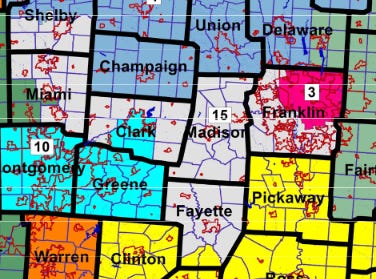Ohio: The 4-Year Congressional Map
Hope you like redistricting, cause we'll be doing more of it in 2025.
Hi all! Ohio holds its primary elections this week. Tomorrow I’ll be focusing on the election and its candidates but today I want to revisit Ohio’s convoluted redistricting process as its turning out to be one of the most unique redistricting stories across the nation.
UPDATE: This map was also invalidated by the state Supreme Court. See the most up-to-date info on Ohio’s congressional districts here.
What’s Going on in Ohio?
To get you up to speed, Republicans fully control the congressional redistricting process in Ohio and meandered through the process throughout last fall: no Democrats supported maps for the required three-fifths vote and a bipartisan redistricting commission failed to draw maps approved by the legislature. These two failures passed the pen back to Republicans who created new maps that were passed by a party-line vote. Barely two days after the new congressional map was enacted, a lawsuit was filed by voters challenging the map. The Ohio Supreme Court threw out this map on January 14 as it violated provisions outlined in a recently passed constitutional amendment aimed to increase fairness in the state’s redistricting process.
Republicans went back to the drawing board and returned with a second map, shown above. This map faces further scrutiny by the Ohio Supreme Court, however a federal court stepped in to cement the usage of these districts for the 2022 elections.
I Thought Districts Lasted for 10 Years…?
Typically, they do! But Ohio’s new constitutional amendment holds a special clause for any congressional maps passed by a simple majority vote:
(C)(3) If the general assembly passes a congressional district plan under division (C)(1) of this section by a simple majority of the members of each house of the general assembly, and not by the vote described in division (C)(2) of this section, all of the following shall apply:
…
(e) If the plan becomes law, the plan shall remain effective until two general elections for the United States house of representatives have occurred under the plan, except as provided in Section 3 of this article.
Due to this clause, Ohio legislators will have to completely redo this process in time for the 2026 midterms. (And they may be forced to do so even sooner if courts eventually deem the districts unconstitutional.)
District Breakdown
Ohio’s new districts are a mess, both for the 2022 congressional elections and beyond. To start, the state lost one congressional seat due to lagging population growth and naturally Republicans axed a previously Democratic-leaning district. This takes the Democratic party down to only four seats leaning in their direction (27% of total seats) despite the fact that roughly 43% of Ohio voters supported Democrats in the last three congressional elections.
The clearest problem with this map is the way it splits counties across the state, something the constitutional amendment explicitly prohibits unless absolutely necessary. The new map splits a whopping 13 counties; only 3 of those are too large to be represented wholly in a single district (each holding one of the Three C’s cities.) It becomes almost comical when looking at OH-15: despite stretching across six different counties, the district only holds one county in its entirety.

The map also displays a bias toward rural voters with the way lines were drawn. Mapmakers carved up most of the state’s metropolitan areas to create districts that stretch from cities and suburbs far into the countryside, capturing enough rural voters to outnumber urban voters. For example, Lorain county, holding much of the suburbs lying west of Cleveland, is separated from nearly all of its neighboring counties and thrown into a heavily rural OH-5. These roughly 200,000 suburban voters are outnumbered by a whopping ~500,000 rural voters who live in counties with population densities six times lower than that of Lorain.
Complicating Campaigns
I’ll dive deeper into this tomorrow but Ohio’s never-ending redistricting process has caused major headaches for candidates and their early campaign strategies. For much of 2022, candidate didn’t quite know for certain what the districts they’d be running in would look like. Even worse, new challengers were uncertain if they’d be facing a formidable incumbent running for re-election. The drama is most pronounced in the Republican primary for the new OH-7.
Republican Bob Gibbs currently represents Ohio’s seventh congressional district, much of which is about to become the new OH-12. To make matters worse, one of his challengers has been endorsed by Donald Trump, turning the campaign into an incredibly expensive primary. Gibbs decided last month to cancel his campaign for re-election, several days after the candidate filing deadline. This means that Bob Gibbs will still appear on the primary ballot but votes for him will not be counted. (The state has been instructed to notify candidates about this at applicable polling places and in relevant absentee voting materials.)
As I mentioned, tomorrow I’ll be taking a look at this week’s primary elections in Ohio and Indiana, with a special focus on candidates in uncontested races.. We must remember: democracy only works when voters have a choice!
Leftover Links
Ohio will be forced to hold a “split” primary this year. What does that even mean?
Still confused about this whole process? Check out this FiveThirtyEight video that recaps Ohio’s redistricting process from start to (almost) finish.
Prepare yourself for Indiana’s primary elections by reviewing the state’s new districts.


